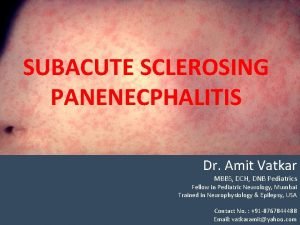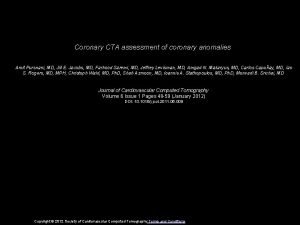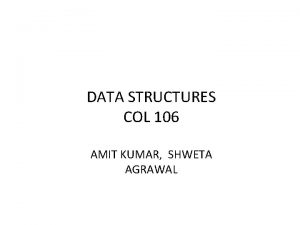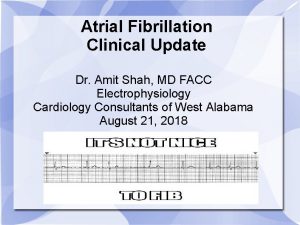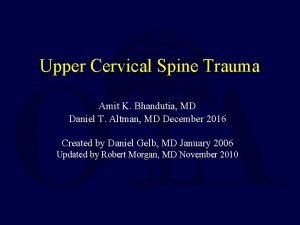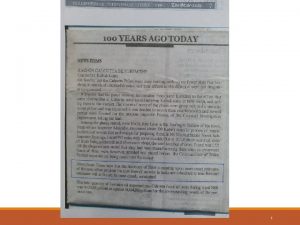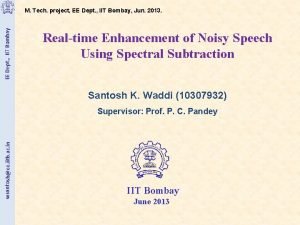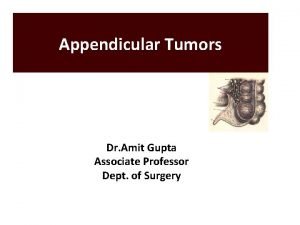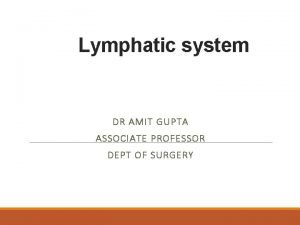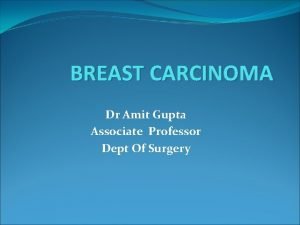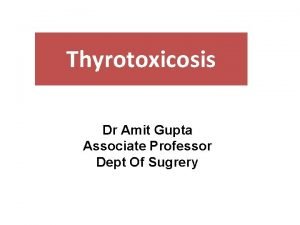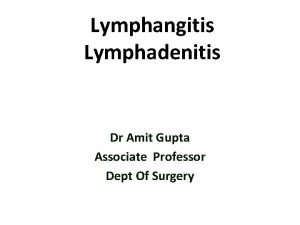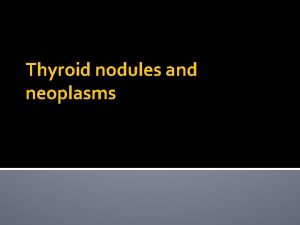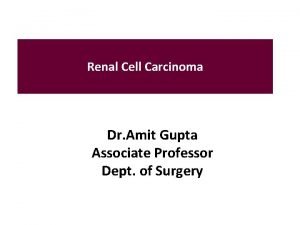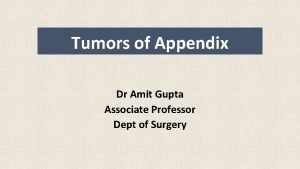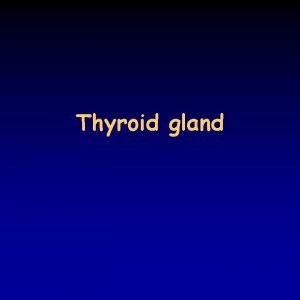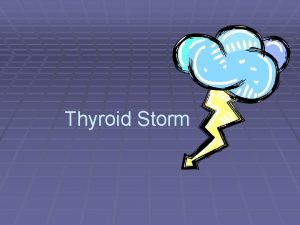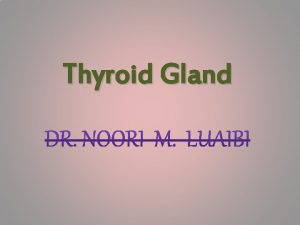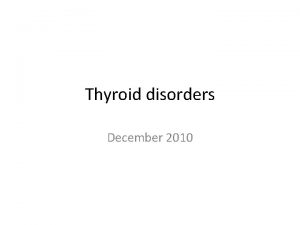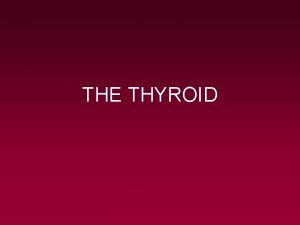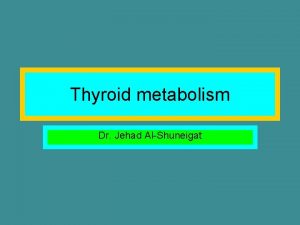Thyroid Neoplasms Dr Amit Gupta Associate Professor Dept









































- Slides: 41

Thyroid Neoplasms Dr. Amit Gupta Associate Professor Dept. of Surgery

Introduction • Six deaths per 1 million people occur annually. • Occurs in about 40 per 1 million people per year • The most common endocrine malignancy • Accounts for 95% of all endocrine cancers • Female to Male Ratio 2. 5: 1

Thyroid Neoplasms Primary Tumours • • • Epithelial Malignant Lymphomas Mesenchymal tumours Metastatic Tumours

Epithelial Thyroid Neoplasms • Tumours of follicular cells – Benign (adenomas) • Follicular adenoma – Malignant (carcinomas) • Follicular carcinoma (10 -20%) • Papillary carcinoma (75 -85%) • Undifferentiated (anaplastic) carcinoma (<5%) • Tumours of C-cells – Medullary thyroid carcinoma (MTC - 5%)

Risk Factors for Thyroid Cancer The only well-established risk factor for differentiated thyroid cancer is head and neck Radiation, especially during infancy Papillary thyroid carcinoma may occur in several rare inherited syndromes, including familial adenomatous polyposis, Gardner's syndrome, and Cowden's disease Patient’s Age and Gender – Malignancy more common in children and adults >60 – Men

Follicular Carcinoma • Second most common form, 10 -20% • Females > Males, average = 45 - 55 yr • Rare in children • Solitary nodule, painless, cold on isotopic scan • 50% 10 yr survival Vs 90%10 yr survival • Haematogenous route is preferred mode of spread

Follicular Carcinoma • Solitary round or oval nodule • Thick capsule • Composed of follicles • Capsular invasion or vascular invasion within or outside capsular wall

Papillary Carcinoma • Commonest thyroid malignancy, 75 -85% • Female: Male = 2. 5: 1 • Mean age at onset = 20 - 40 yr • May affect children • Prior head & neck radiation exposure • Indolent, slow-growing painless mass cold on isotopic scan • Cervical lymphadenopathy may be presenting feature

Papillary Carcinoma • Variable size (microscopic to several cm) • Solid or cystic • Infiltrative or encapsulated • Solitary or multicentric (20%)

Papillary Carcinoma Nuclear Features – Optically clear (ground glass, Orphan Annie) nuclei – Nuclear pseudoinclusions or nuclear grooves

Papillary Carcinoma Prognosis Excellent but following factors play important role: – – – Age and sex Size Multicentricity Extra-thyroid extension Distant metastasis Total encapsulation, pushing margin of growth & cystic change

Anaplastic Carcinoma • Rare; < 5% of thyroid carcinomas • Highly malignant and generally fatal < 1 yr. • Elderly 65 yrs; females slightly > males • Rapidly enlarging bulky neck mass • Dysphagia, dyspnoea, hoarseness

Anaplastic Carcinoma • Large, firm, necrotic mass • Frequently replaces entire thyroid gland • Extends into adjacent soft tissue, trachea and oesophagus • Highly anaplastic cell on histology with: – Giant, spindle, small or mix cell population • Foci of papillary or follicular differentiation

Anaplastic Carcinoma • Cellular pleomorphism • +/- multinucleated giant cells • High mitotic activity • Necrosis

Medullary Thyroid Carcinoma (MTC) • Malignant tumour of thyroid C cells producing Calcitonin • 5 % of all thyroid malignancies • Sporadic (80%) • Rest in the setting of MEN IIA or B or as familial without associated MEN syndrome

Medullary Thyroid Carcinoma (MTC) Sporadic MTC – Middle-aged adults – Female: male = 1. 3: 1 – Unilateral involvement of gland – +/- cervical lymph node metastases – Indolent course with 60 -70% 5 -yr survival after thyroidectomy

Multiple Endocrine Neoplasia Types IIA & IIB • Germ-line mutation in Ret protooncogene on chromosome 10 q 11. 2 • MEN IIA: MTC, phaeochromocytoma, parathyroid adenoma or hyperplasia • MEN IIB: MTC, phaeochromocytoma, mucosal ganglioneuromas, Marfanoid habitus, other skeletal abnormalities

Medullary Thyroid Carcinoma (MTC) • Histology same for sporadic & familial • Solid, lobular or insular growth patterns • Tumour cells round, polygonal or spindleshaped • Amyloid deposits in many cases

Medullary Thyroid Carcinoma (MTC) • Amyloid deposits stain orange-red with Congo Red stain

Clinical Manifestation • Most patients are euthyroid and present with a thyroid nodule • Symptoms such as dysphagia, dyspnea and hoarseness usually indicate advanced disease • Ipsilateral Cervical lymph glands may also be present.

Diagnosis • Serum TSH • Fine Needle Aspiration Cytology (FNA) • High Resolution Thyroid US- helpful in detecting non palpable nodule and solid versus cystic lesion • Thyroid Isotope Scanning- to assess functional activity of a nodule

Fine Needle Aspiration • Procedure of Choice – Fast, minimally invasive and few risk • Incidence of False positive: 1% • Incidence of False negative: 5% • FNA is not a tissue diagnosis • Limitation of FNA: cannot distinguish a benign follicular from a malignant lesion.

FNA Results of Thyroid Nodule


Staging For Differentiated Thyroid Cancer In differentiated thyroid carcinoma, several classification and staging systems have been introduced. However, no clear consensus has emerged favoring any one method over another • • AMES system/AGES System/GAMES system TNM system MACIS system National Thyroid Cancer Treatment Cooperative Study (NTCTCS)

Prognosis • GAMES scoring (Papillary & Follicular Cancer) – – – G Grade A Age of patient when tumor discovered M Metastases of the tumor (other than Neck LN) E Extent of primary tumor S Size of tumor (>5 cm) The patient is then placed into a high or low risk Category Age for poor prognosis has been raised from 45 to 55 years (AJCC 8 th Edition)

(GAMES)

Prognosis of Thyroid Carcinomas Papillary Best prognosis Follicular Medullary Anaplastic Worst prognosis

Hürthle Cell Neoplasms • More aggressive than other differentiated thyroid carcinomas (higher mets/lower survival rates) • Decreased affinity for I 131 • Need to differentiate from benign/malignant • 65% of tumors > 4 cm are malignant • If malignant, needs total thyroidectomy and I 131 with thyroglobulin assays • Mets may be more sensitive to I 131 than primary

Secondary Tumours Direct extensions from: larynx, pharynx, oesophagus Metastasis from: renal cell carcinoma, large bowel carcinoma, malignant melanoma, lung carcinoma, breast carcinoma

Treatment The main treatment of papillary carcinoma of the thyroid is surgical resection. For lesions <1 cm, there is general agreement in the literature that lobectomy plus isthmectomy is the appropriate treatment. For adults with lesions larger than 2 cm, a total thyroidectomy is favored by most surgeons. Patients with history of exposure to ionizing radiation of the head and neck should have total thyroidectomy

Controversies in Treatment Total Vs Lobectomy • Controversy exists about the use of total thyroidectomy versus lobectomy and isthmectomy in adults with a 1 to 2 -cm lesions • Role of Lymph node dissection also debated

Central Lymph Node Dissection Central compartment =the region bounded by the jugular veins, the hyoid bone, and the sternal notch All central nodes removed at time or procedure Removal of Central Nodes important in medullary and Hurthle Cell Ca • Microscopic spread is high • Do not take up I 131 and cannot be ablated

Lateral Lymph Node Dissection Diseased nodes lateral to the jugular vein =modified radical neck dissection Removal of LN’s anterior and posterolateral to the IJV from the mastoid to the subclavian vessels inferiorly and laterally to spinal accessory nerve (Level 2 -5) Sparing the internal jugular vein, spinal accessory nerve, and sternocleidomastoid muscle

Treatment

Complications of Surgery Hypocalcemia -devascularization of parathyroid about 5%, which resolves in 80% of these cases in about 12 months Recurrent Laryngeal Nerve Injury-either traction induced or division. less than 3% Bleeding wound hematomas

Postoperative management for thyroid cancer Two principles: • Radioiodine remnant ablation • Adminstration of Thyroid Hormone – To suppress TSH and growth of any residual thyroid – To maintain patient euthyroid • Maintain TSH level 0. 1 u. U/ml in low risk pts • Maintain TSH Level < 0. 1 u. U/ml in high risk pts

Postoperative RAI Recommendations: • Postoperative remnant ablation for all patients with differentiated thyroid carcinoma 45 years of age or older • Those with primary tumor 1. 5 cm in diameter or more • Extrathyroidal disease, whether manifested by direct invasion through the capsule of the gland or local or regional metastases.


Radioiodine therapy The nonsurgical treatment for papillary thyroid carcinoma is radioiodine (131 -I). Radioiodine has three uses in the postoperative treatment of patients with thyroid cancer: – ablation of residual thyroid tissue – imaging for possible recurrent disease – treatment of residual or recurrent thyroid cancer

External Beam Radiotherapy and Chemotherapy External Radiation required to control unresectable cancer. Chemotherapy may occasionally be beneficial in patients with progressive symptomatic thyroid carcinoma that is unresponsive or not amenable to surgery, radioiodine therapy, or external radiotherapy
 Promotion from assistant to associate professor
Promotion from assistant to associate professor Neoplasms
Neoplasms Amit gupta microsoft
Amit gupta microsoft Amit sheshinski
Amit sheshinski Amit nanavati md
Amit nanavati md Amit somech
Amit somech Col 106 amit kumar
Col 106 amit kumar Dr amit vatkar
Dr amit vatkar Col 106 amit kumar
Col 106 amit kumar Amit shah 1800flowers
Amit shah 1800flowers Amit idg500
Amit idg500 Dr gary vitale louisville ky
Dr gary vitale louisville ky Journal of cardiovascular computed tomography
Journal of cardiovascular computed tomography Col 106 amit kumar
Col 106 amit kumar Amit chopra md
Amit chopra md Col 106 amit kumar
Col 106 amit kumar Dr amit bhan
Dr amit bhan Amit sahai
Amit sahai Dr amit shah cardiologist
Dr amit shah cardiologist Amit tamrakar
Amit tamrakar Amit dio egizio
Amit dio egizio Amit bhatt wri
Amit bhatt wri Amit wireless
Amit wireless Amit kumar microsoft
Amit kumar microsoft Daniel deutch
Daniel deutch Nadav amit
Nadav amit Amit bhandutia
Amit bhandutia Cos 423
Cos 423 Amit garg irse
Amit garg irse La dept of revenue
La dept of revenue Nebraska dept of agriculture
Nebraska dept of agriculture Dept a
Dept a Gome dept
Gome dept Dept. name of organization (of affiliation)
Dept. name of organization (of affiliation) Dept c13 nmr
Dept c13 nmr Dept of education
Dept of education Hoe dept
Hoe dept Ohio employment first
Ohio employment first Fl dept of agriculture
Fl dept of agriculture Ee dept iitb
Ee dept iitb La revenue dept
La revenue dept Central islip fire department
Central islip fire department







